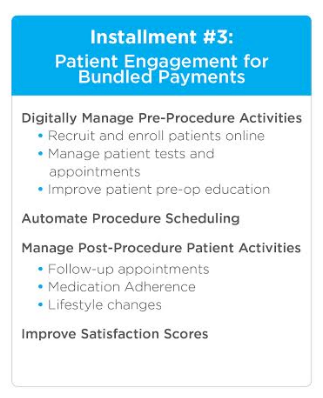Article
MACRA Patient Engagement Cheat Sheet #2
Author(s):
Patient Engagement Strategies for MIPS Success
The first major impact of the Medicare Access and CHIP Reauthorization Act (MACRA) that most providers will feel comes from the Merit-based Incentive Payment System (MIPS) program. MIPS rolls up and replaces the Meaningful Use, Physician Value-Based Payment Modifier, and Physician Quality Reporting System programs. The only providers who won’t be affected by MIPS are those who are part of an Advanced Alternative Payment Model (APM) or those who have extremely low Medicare patient volume. As a result, for the vast majority of providers, MIPS will be the most significant mandatory value-based program they have been subjected to thus far.
The MACRA final rule contained a number of changes to MIPS that eased the first-year burden on providers by giving them 3 different approaches from which to choose:

The 2017 financial impact of MIPS is minimal. Therefore, providers shouldn’t focus too much of their MIPS strategy on 2017 performance. However, delaying planning would be a mistake. Starting in 2018, MIPS requirements grow while the anticipated penalties and bonuses also scale up quickly. Therefore, wise providers will use 2017 to develop winning MIPS strategies for the year 2018 and beyond.
Providers will be scored under MIPS in 4 categories:
- Quality
- Cost/Resource Use
- Clinical Practice Improvement Activities
- Advancing Care Information
An effective patient engagement strategy can help providers improve and report their scores across all these categories.
Quality Category
Under MIPS, providers can choose which measures (from a list of 200) they want to report based on their specialty and patient mix. Therefore, it would be impossible to address all of them in one article. However, the following examples should illustrate how engaging patients helps meet quality goals.
Meaningful patient engagement has been shown to improve a number of outcome measures that map to specific MIPS quality metrics. Engaged patients have better medication compliance which, in turn, affects outcomes. For example, if you are tracking the “Hemoglobin A1c Poor Control” metric, you will certainly want your patients to take their medication consistently.
Patient engagement can also improve data collection. For example, if you are tracking the “Pain brought under control within 48 Hours” metric, your patients could receive automatic reminders and use a smartphone app to report pain levels without the need for you to contact them.
Once individual providers and provider organizations have narrowed down the list of metrics they are targeting, they should consult with patient engagement experts to determine how best to leverage appropriate technologies to manage toward these metrics.
Cost/Resource Use Category
This category is unique in that a provider’s score is automatically calculated from CMS claims data. Rather than targeting specific measures, providers are incentivized to improve overall cost efficiency. In general, this means reducing preventable healthcare costs. One of the most effective ways to use patient engagement to achieve this goal is to provide the most expensive patients (those with multiple chronic conditions) with tools to manage their conditions between visits.
At first glance it may seem that the sickest (and therefore most costly) patients aren’t always capable of using at-home technology for self-management. This is true, but patient engagement takes many forms, not all of which require active involvement of the patient. Examples include: a patient’s family member using technology to manage the patient’s conditions, an automatic device that reports data (and can trigger an alert) with minimal patient involvement, or simply providing patients with a daily reminder to take their medication.
Clinical Practice Improvement Activities (CPIA) Category
Similar to the Quality category, CPIA offers providers a long list of measures and lets them choose which ones make the most sense for their patient population. Some of these measures, specifically around population management, are perfect candidates for patient engagement. Simply quoting from a few of them should make the connection to patient engagement obvious:
“Proactively manage chronic and preventive care… Use reminders and outreach to alert and educate patients about services due”
“Access to an enhanced patient portal that provides up to date information related to relevant chronic disease health or blood pressure control, and includes interactive features allowing patients to enter health information and/or enables bidirectional communication about medication changes and adherence.”
Advancing Care Information (ACI) Category
The ACI category replaces the Medicare EHR Incentive Program (also known as “Meaningful Use”). Patient engagement is necessary to meet the requirements for patient education, patients’ electronic access to their records, and the ability to securely message their providers. If your patient engagement platform is a Certified EHR Technology, it will make reporting easier and can earn you additional bonus points in this category.Plus, advanced patient engagement platforms can help you collect and report additional metrics, further increasing your score and potential financial bonuses.
Conclusion
A well-considered patient engagement strategy can help you meet your MIPS requirements while providing better care for your patients. All of this can be accomplished without changing your protocols or procedures and with minimal impact on your operations and workflow.
Finally, consider how the practice adjustments you make for MIPS will help (or not help) you meet other industry changes. According to David Katz, executive director of the Advisory Board Company, the forces of consumerism and activated employers will have a far more profound impact on provider business than will MACRA. Highly active consumers and employers are certain to demand an unprecedented level of patient engagement. Therefore, investing in these technologies for MACRA will position you and your organization for the next big wave of change.






